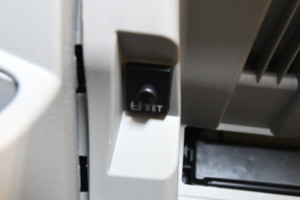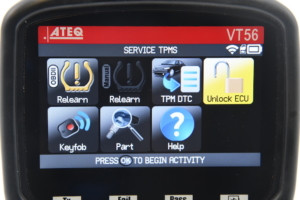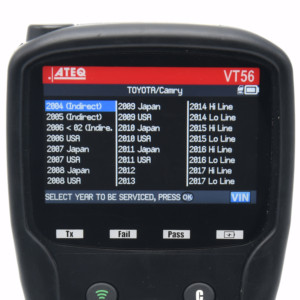Having trouble with your tire pressure monitoring system? Resetting the TPMS on your 2015 Toyota Camry is simple and can often be done in a few easy steps, and millertoyota.net is here to guide you through the process, ensuring your vehicle’s safety systems function correctly. Whether you’re dealing with a flashing TPMS light after a tire change, tire rotation, or simply adjusting your tire pressures, understanding the reset procedure can save you a trip to the mechanic and keep you safe on the roads of Boise, Idaho, with properly inflated tires. This article will explore both direct and indirect TPMS systems, OBD relearn procedures, and troubleshooting tips, using sensor recalibration and proper tire inflation for optimal performance.
1. Understanding TPMS and Your 2015 Toyota Camry
Let’s dive in! TPMS, or Tire Pressure Monitoring System, is an electronic system designed to monitor the air pressure inside your tires and alert you when it falls significantly below the recommended level. This is crucial for maintaining optimal tire performance, fuel efficiency, and overall safety.
1.1. Direct vs. Indirect TPMS: Which Does Your Camry Have?
To properly reset your TPMS, it’s essential to know which type your 2015 Camry uses:
- Direct TPMS: This system has pressure sensors inside each tire that directly measure tire pressure and transmit the data to the vehicle’s ECU (Electronic Control Unit).
- Indirect TPMS: This system uses the vehicle’s ABS (Anti-lock Braking System) sensors to monitor the rotational speed of each wheel. If a tire loses pressure, its rotational speed increases, which the system interprets as low pressure.
The 2015 Toyota Camry uses a direct TPMS system, which means each wheel has a sensor inside. Knowing this is the first step in a successful reset.
1.2. Why Reset Your TPMS?
There are several reasons why you might need to reset your TPMS:
- Tire Pressure Adjustment: After inflating your tires, the TPMS needs to be reset to recognize the new pressure.
- Tire Rotation: Rotating your tires can sometimes confuse the TPMS, requiring a reset to ensure accurate readings.
- Tire Replacement: When you replace your tires or TPMS sensors, the system needs to be reset to learn the new sensor IDs.
- TPMS Sensor Replacement: If a sensor fails and is replaced, the new sensor must be programmed and the system reset.
- Fluctuations due to Temperature Changes: Significant temperature changes can affect tire pressure, triggering the TPMS light. Resetting the system after adjusting the pressure can resolve this.
1.3. The Importance of Properly Functioning TPMS
Maintaining a properly functioning TPMS is crucial for several reasons:
- Safety: Underinflated tires can lead to decreased handling, increased stopping distances, and a higher risk of tire failure or blowouts.
- Fuel Efficiency: Properly inflated tires reduce rolling resistance, improving your vehicle’s fuel economy.
- Tire Life: Underinflated tires wear unevenly and can significantly shorten their lifespan.
- Optimal Performance: Correct tire pressure ensures optimal ride comfort and handling.
2. Step-by-Step Guide: Resetting the TPMS on Your 2015 Toyota Camry
Since your 2015 Camry uses a direct TPMS, the reset procedure typically involves an OBD relearn. Here’s how to do it:
2.1. What You’ll Need
- TPMS Tool: A TPMS tool with OBDII (On-Board Diagnostics II) functionality is required to communicate with your vehicle’s ECU and transfer sensor data.
- OBDII Module: This module connects the TPMS tool to your vehicle’s OBDII port.
- Correct Tire Pressure: Ensure all tires are inflated to the recommended pressure listed on the sticker inside your driver’s side doorjamb.
2.2. OBD Relearn Procedure
This procedure requires a TPMS tool with OBDII capabilities to transfer sensor data to your vehicle’s ECU.
-
Inflate Tires: Ensure all tires, including the spare if applicable, are inflated to the correct pressure as indicated on the tire placard, typically found on the driver’s side doorjamb.
-
Activate TPMS Sensors:
- Use the TPMS tool to activate each sensor.
- Hold the TPMS tool on the left front tire sidewall, near the valve stem.
- Follow the tool’s prompts to read the sensor data.
- Repeat this process for the right front, right rear, and left rear tires (and the spare tire, if equipped).
-
Connect OBDII Module:
- Locate the OBDII port under the dashboard on the driver’s side.
- Plug the OBDII module into the port.
-
Initiate Relearn:
- Turn the ignition ON, but do not start the engine.
- Follow the TPMS tool prompts to initiate the relearn procedure.
- Typically, you will need to press “OK” or a similar button on the tool to transfer the TPMS sensor data to the vehicle’s ECU.
-
Complete Relearn:
- Once the tool indicates that the relearn is complete, disconnect the OBDII module from the DLC.
- Turn the ignition OFF, then ON again.
-
Drive the Vehicle:
- Drive the vehicle for at least 5 minutes at a speed of 12 mph or more. This allows the system to fully register the new sensor data.
2.3. Alternative Method: Using the TPMS Reset Button (If Equipped)
Some Toyota models have a TPMS reset button, typically located below the steering wheel or in the glove box. While the 2015 Camry usually requires an OBD relearn, it’s worth checking for this button. If present, follow these steps:
-
Inflate Tires: Ensure all tires are inflated to the recommended pressure.
-
Locate the TPMS Reset Button: Look for a button labeled “SET” or “TPMS RESET”.
-
Initiate Reset:
- Turn the ignition ON, but do not start the engine.
- Press and hold the TPMS reset button until the TPMS light on the dashboard blinks a few times.
-
Drive the Vehicle: Drive for several minutes to allow the system to recalibrate.
2.4. Common Pitfalls to Avoid
- Incorrect Tire Pressure: Always use the recommended tire pressure from the sticker on your doorjamb, not the maximum pressure listed on the tire itself.
- Skipping the Driving Step: The system needs time to fully register the new sensor data. Don’t skip the driving portion of the reset procedure.
- Using an Incompatible TPMS Tool: Ensure your TPMS tool is compatible with your 2015 Toyota Camry.
- Ignoring the Spare Tire: If your Camry has a spare tire with a TPMS sensor, it must also be included in the reset procedure.
- Failing to Unlock the ECU: In some cases, the ECU may need to be unlocked before a relearn can be performed. Some advanced TPMS scan tools have this capability.
3. Troubleshooting: What to Do If the TPMS Light Stays On
Sometimes, despite following the reset procedure, the TPMS light may remain illuminated. Here are some common reasons and troubleshooting steps:
3.1. Sensor Issues
- Dead Sensor Battery: TPMS sensors have a limited lifespan, typically around 5-7 years. If the battery is dead, the sensor needs to be replaced.
- Damaged Sensor: Sensors can be damaged by impacts, corrosion, or improper installation.
- Incorrect Sensor: Ensure the replacement sensor is the correct one for your 2015 Toyota Camry.
3.2. System Malfunctions
- Faulty ECU: Although rare, a malfunctioning ECU can prevent the TPMS from working correctly.
- Wiring Issues: Damaged or corroded wiring can disrupt communication between the sensors and the ECU.
3.3. Using a Diagnostic Scan Tool
A diagnostic scan tool can help identify the specific issue by reading TPMS diagnostic trouble codes (DTCs). Some common codes include:
| DTC Code | Description |
|---|---|
| C2111/11 | Transmitter ID1 Operation Stop |
| C2121/21 | No Signal from Transmitter ID1 in Main Mode |
| C2141/41 | Transmitter ID1 Error |
| C2171/71 | Transmitter ID1 Not Registered in Main Mode |
3.4. High Line vs. Low Line TPMS Systems
From 2014-2019, the Toyota Camry offered both Low Line and High Line TPMS systems. It is crucial to know which system your vehicle has.
- Low Line TPMS System: The low line TPMS system will only display the TPMS light on the dashboard when there is an issue with the tire pressure.
- High Line TPMS System: The high line TPMS system displays the tire pressure of each tire on the dash or instrument display. If there is a sensor malfunction, the TPMS sensor will report the location of the sensor in real time.
Installing the incorrect sensor (for example, a Low Line sensor on a High Line system) can cause the system not to function properly, and it may display 0 PSI on the dashboard.
3.5. When to Seek Professional Help
If you’ve tried the reset procedure and troubleshooting steps without success, it’s time to consult a professional. A qualified mechanic can diagnose the issue and perform the necessary repairs or replacements. Miller Toyota, located at 208 N Maple Grove Rd, Boise, ID 83704, United States, and reachable by phone at +1 (208) 376-8888, offers expert TPMS services and can help resolve any issues you may be experiencing.
4. TPMS Sensor Replacement: A Detailed Look
Replacing a TPMS sensor involves several steps to ensure proper installation and functionality.
4.1. Choosing the Right Sensor
Selecting the correct TPMS sensor for your 2015 Toyota Camry is crucial. Here are the OE sensor types:
- 2006 – 2011: Pacific, 42067-06011 or 42067-33011
- 2012 – 2019: Pacific, low line 42067-06020
- 2014-2019: Pacific, high line 42067-06030
Additionally, there are aftermarket options like Universal, Hybrid, Programmable, Configurable, and OE-style sensors.
4.2. Step-by-Step Replacement Procedure
-
Gather Tools and Materials:
- New TPMS sensor
- Tire changing machine
- TPMS service kit (including new valve core, cap, and grommet)
- Torque wrench
- TPMS diagnostic tool
-
Remove the Wheel and Tire:
- Safely lift the vehicle and remove the wheel with the faulty sensor.
- Deflate the tire completely.
-
Disassemble the Tire:
- Use a tire changing machine to carefully break the bead and remove the tire from the rim.
-
Remove the Old Sensor:
- Locate the TPMS sensor on the inside of the rim.
- Remove the nut or screw securing the sensor.
- Carefully detach the sensor from the valve stem.
-
Install the New Sensor:
- Install a new TPMS service kit (valve core, cap, and grommet).
- Attach the new sensor to the valve stem, ensuring it sits flush against the rim.
- Tighten the nut or screw to the manufacturer’s specified torque (typically around 48 in-lbs or 5.4 Nm).
-
Reassemble the Tire:
- Mount the tire back onto the rim using the tire changing machine.
- Inflate the tire to the recommended pressure.
-
Perform TPMS Relearn:
- Use a TPMS tool to program the new sensor ID to the vehicle’s ECU.
- Follow the OBD relearn procedure outlined earlier in this article.
-
Test the System:
- Drive the vehicle to ensure the TPMS light turns off and the system is functioning correctly.
4.3. Aftermarket Sensor Options
There are several types of aftermarket TPMS sensors available:
- Universal Sensors: These can be programmed to work with a wide range of vehicles.
- Programmable Sensors: These need to be programmed with the specific vehicle information before installation.
- OE-Style Sensors: These are designed to be direct replacements for the original equipment sensors.
4.4. Benefits of Professional Installation
While it’s possible to replace a TPMS sensor yourself, professional installation offers several advantages:
- Expertise: Technicians have the knowledge and experience to properly install and program the sensors.
- Specialized Tools: Professionals have access to specialized tools, such as tire changing machines and TPMS diagnostic tools.
- Warranty: Professional installation often comes with a warranty on the parts and labor.
5. Maintaining Your TPMS for Long-Term Reliability
To ensure your TPMS continues to function properly, consider these maintenance tips:
5.1. Regular Tire Pressure Checks
Check your tire pressure at least once a month and before long trips. Use a reliable tire pressure gauge and ensure your tires are inflated to the recommended pressure.
5.2. Proper Tire Inflation
Maintaining the correct tire pressure is crucial for TPMS accuracy and overall vehicle performance.
5.3. Inspecting TPMS Sensors
During tire rotations or replacements, inspect the TPMS sensors for any signs of damage or corrosion.
5.4. Replacing TPMS Service Kits
Always replace the TPMS service kit (valve core, cap, and grommet) whenever you replace a tire or TPMS sensor.
5.5. Avoiding Harsh Chemicals
Avoid using harsh chemicals or cleaners on your wheels, as they can damage the TPMS sensors.
6. Understanding Toyota TPMS Specifics
Toyota’s TPMS systems have a few unique aspects that are worth noting.
6.1. Toyota TPMS Vehicles Manufactured in the USA vs. Japan
When selecting the Make, Model, and Year of your vehicle on a TPMS tool, you may notice two options for the Year (e.g., “2008 USA” or “2008 Japan”). Toyota Camrys sold in the USA were manufactured in both the USA and Japan. It’s important to select the correct option because there can be slight differences in how the TPMS information is transferred to the vehicle’s ECU.
To determine where your Toyota Camry was manufactured, check the vehicle’s VIN barcode. The first character of the VIN indicates the country of origin:
- “1” indicates the vehicle was manufactured in the USA.
- “J” indicates the vehicle was manufactured in Japan.
6.2. Toyota TPMS Vehicles with Spare Tire
Some Toyota Camry models have the option to include a spare tire with a TPMS sensor. During the relearn procedure, you must also activate the spare tire TPMS sensor to reset the system properly and write all the TPMS IDs to the vehicle’s ECU. If the spare tire is not activated, the TPMS light will remain on.
To determine if your Toyota Camry came with a spare tire, check for the following:
- Tire or Donut: Does your vehicle have a full-size tire or a donut in the trunk? If there is a tire, it must be fitted with a TPMS sensor and inflated to the correct pressure.
- Trunk Size: If there is no tire, the size of the trunk can indicate whether it originally came with a spare tire. If the trunk looks large enough to fit a full-size tire, it likely came with a spare tire.
The order for activating the sensors during the relearn procedure is typically: Left Front, Right Front, Right Rear, Left Rear, Spare Tire.
6.3. Indirect TPMS for Toyota Camry 2004-2006
Toyota Camry models from 2004 to February 2006 used an indirect TPMS system. This system does not have sensors in the tires and communicates tire pressure through the ABS system. In February 2006, Toyota switched to a direct TPMS system.
6.4. High Line vs. Low Line TPMS Systems, Toyota Camry 2014-2019
From 2014 through 2019, the Toyota Camry offered both low line and high line TPMS systems. It’s important to know which system you are working with when resetting the TPMS system.
6.4.1. Low Line TPMS System
A low line TPMS system indicates low tire pressure with the TPMS light only. You must use a tire pressure gauge or TPMS tool to read the tire pressure of the tire. When the tire pressure is underinflated by 25%, the light will stay on until the tire is filled with the proper amount of air. If there is a system malfunction, the light will flash for one minute when starting your vehicle.
6.4.2. High Line TPMS System
A high line TPMS system displays the tire pressure of each tire on the dash or instrument display. If there is a sensor malfunction, the TPMS sensor will report the location of the sensor in real-time.
7. Visiting Miller Toyota for TPMS Service
If you’re in the Boise area and need assistance with your TPMS, consider visiting Miller Toyota.
7.1. Expert Technicians
Miller Toyota employs certified technicians who are trained to diagnose and repair TPMS issues on all Toyota models.
7.2. State-of-the-Art Equipment
The dealership is equipped with the latest TPMS diagnostic and programming tools to ensure accurate and efficient service.
7.3. Genuine Toyota Parts
Miller Toyota uses only genuine Toyota parts, ensuring the highest quality and compatibility.
7.4. Convenient Location and Contact Information
Miller Toyota is located at 208 N Maple Grove Rd, Boise, ID 83704, United States. You can reach them by phone at +1 (208) 376-8888.
7.5. Additional Services Offered
In addition to TPMS service, Miller Toyota offers a wide range of automotive services, including:
- Oil changes
- Tire rotations
- Brake service
- Battery replacement
- And more!
8. TPMS and Tire Safety: A Deeper Dive
The TPMS is more than just a warning light; it’s a critical component of your vehicle’s safety system.
8.1. The Physics of Tire Pressure
Tire pressure is affected by several factors, including:
- Temperature: As temperature increases, tire pressure increases, and vice versa.
- Altitude: Higher altitudes typically result in lower tire pressure.
- Driving Conditions: Aggressive driving can increase tire pressure due to heat buildup.
8.2. The Impact of Underinflation
Underinflated tires can lead to:
- Increased Rolling Resistance: This reduces fuel efficiency and increases tire wear.
- Reduced Handling: Underinflated tires can make your vehicle feel sluggish and less responsive.
- Increased Risk of Blowouts: Underinflated tires are more likely to overheat and fail, especially at high speeds.
8.3. The Impact of Overinflation
Overinflated tires can lead to:
- Reduced Traction: Overinflated tires have a smaller contact patch with the road, reducing traction.
- Uneven Wear: Overinflated tires tend to wear out in the center of the tread.
- Ride Discomfort: Overinflated tires can make the ride feel harsh and bumpy.
8.4. Nitrogen vs. Air
Some drivers choose to fill their tires with nitrogen instead of air. Nitrogen has several potential benefits:
- More Stable Pressure: Nitrogen is less affected by temperature changes than air.
- Reduced Moisture: Nitrogen is a dry gas, which can help prevent corrosion inside the tire.
- Slower Leakage: Nitrogen molecules are larger than air molecules, so they may leak out of the tire more slowly.
9. The Future of TPMS Technology
TPMS technology continues to evolve, with new features and capabilities being developed.
9.1. Advanced TPMS Systems
Future TPMS systems may include:
- Real-Time Pressure Monitoring: Continuously displays the pressure of each tire on the dashboard.
- Temperature Monitoring: Alerts the driver to excessive tire temperatures.
- Automatic Inflation: Automatically adjusts tire pressure to the optimal level.
- Integration with Navigation Systems: Provides alerts and recommendations based on road conditions and driving habits.
9.2. TPMS and Autonomous Vehicles
As autonomous vehicles become more common, TPMS will play an even more critical role in ensuring safety and performance.
9.3. The Role of Data Analytics
TPMS data can be used to identify trends and patterns that can help improve tire design and maintenance practices.
10. FAQs: All About TPMS Reset on Your 2015 Toyota Camry
Here are some frequently asked questions about resetting the TPMS on your 2015 Toyota Camry:
10.1. Why is my TPMS light on even after inflating my tires?
The TPMS light may stay on if the system needs to be reset after inflating the tires. Follow the OBD relearn procedure to reset the system.
10.2. Can I reset the TPMS without a special tool?
For a 2015 Toyota Camry with a direct TPMS system, a TPMS tool with OBDII functionality is typically required for a proper reset.
10.3. How often should I check my tire pressure?
It is recommended to check your tire pressure at least once a month and before long trips.
10.4. What does the TPMS light mean?
A solid TPMS light indicates that one or more of your tires is significantly underinflated. A flashing TPMS light may indicate a system malfunction or a sensor issue.
10.5. How long do TPMS sensors last?
TPMS sensors typically last for 5-7 years, depending on usage and environmental conditions.
10.6. Can I replace TPMS sensors myself?
While it is possible, professional installation is recommended to ensure proper installation and programming.
10.7. Where is the TPMS reset button located in my Toyota Camry?
The 2015 Toyota Camry typically does not have a TPMS reset button. The reset usually requires an OBD relearn procedure.
10.8. What is the correct tire pressure for my 2015 Toyota Camry?
The correct tire pressure is listed on the sticker inside your driver’s side doorjamb.
10.9. Why is my TPMS light flashing?
A flashing TPMS light usually indicates a system malfunction, such as a faulty sensor or an issue with the ECU.
10.10. What should I do if the TPMS light comes on while driving?
Safely pull over to the side of the road and check your tire pressures. If one or more tires are significantly underinflated, inflate them to the recommended pressure. If the light remains on, consult a professional mechanic.
Don’t let a pesky TPMS light stress you out! Armed with this comprehensive guide, you can confidently tackle the TPMS reset on your 2015 Toyota Camry. Whether you choose the DIY route or prefer the expertise of Miller Toyota, you’ll be back on the road with peace of mind, knowing your tires are properly inflated and your TPMS is functioning flawlessly.
Ready to experience the Miller Toyota difference? Visit millertoyota.net today to explore our wide selection of new and used Toyota vehicles, schedule a service appointment, or contact our friendly team for expert advice. Find your dream car, receive top-notch service, and enjoy exclusive offers – all at millertoyota.net! Your satisfaction is our priority, and we look forward to serving you in Boise, Idaho.
 DSC_5097
DSC_5097
 Toyota unlock ECU
Toyota unlock ECU
 toyota camry vt56-1
toyota camry vt56-1

